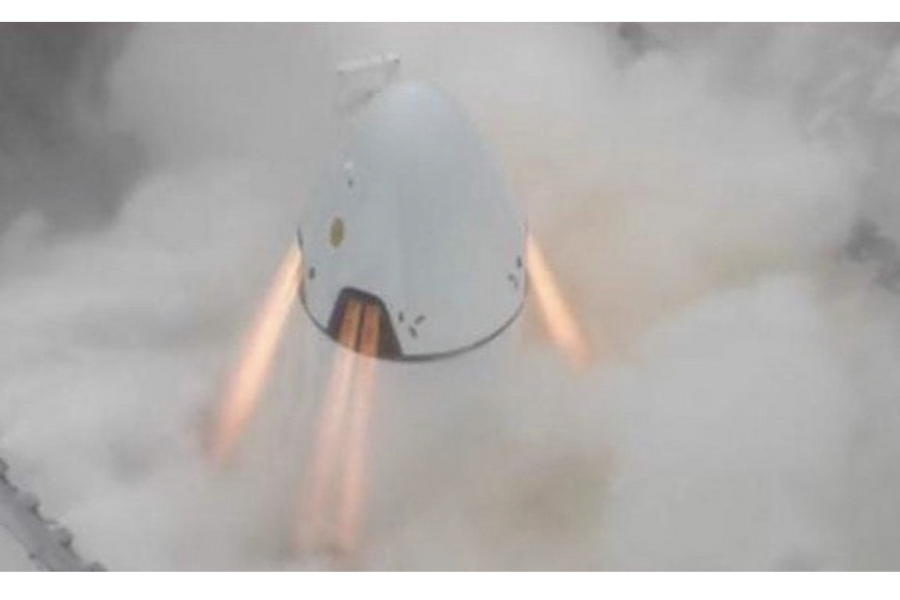SpaceX to test rocket ejection system with dummy
Loading...
SpaceX's Dragon astronaut taxi will blast off with a dummy on board Wednesday (May 6) in a crucial safety test, and you can watch all of the action live.
An unmanned but dummy-carrying Dragon test vehicle is scheduled to launch Wednesday from Florida's Cape Canaveral Air Force Station at 9 a.m. EDT (1300 GMT), though the window extends to 2:30 p.m. EDT (1830 GMT). The Dragon pad abort test, as it is called, is designed to see how a SpaceX crew capsule would perform in the event of a launch emergency. You can watch the SpaceX test launch live on Space.com courtesy of NASA TV.
Dragon is one of two private American spacecraft, along with Boeing's CST-100 capsule, that NASA hopes will be ferrying astronauts to and from the International Space Station by 2017. The agency awarded SpaceX and Boeing $2.6 billion and $4.2 billion, respectively, last September to finish their development work on the vehicles. [SpaceX's Dragon Spaceship Pad Abort Test in Photos]
The crew-carrying Dragon is a modified, upgraded version of the unmanned capsule that already flies cargo to the space station under a separate $1.6 billion NASA contract. One of the upgrades SpaceX has installed is a launch abort system, which comprises eight SuperDraco engines built into Dragon that can fire up and blast the spacecraft away from danger if need be. These engines roared to life Tuesday (May 5) during a "hold-down firing" test at Cape Canaveral ahead of the pad abort test, SpaceX CEO and founder Elon Musk announced via Twitter.
"This system is designed to quickly get the crew and spacecraft away from the rocket in the event of a potential failure," SpaceX representatives wrote Monday (May 4) in a description of the pad abort trial. "It is similar to an ejection seat for a fighter pilot, but instead of ejecting the pilot out of the spacecraft, the entire spacecraft is 'ejected' away from the launch vehicle."
It's this system that is being tested on Wednesday.
During the trial, Dragon will sit atop a truss structure rather than SpaceX's Falcon 9 rocket, its usual ride. If all goes according to plan, the eight SuperDracos will ignite, together generating 120,000 pounds of thrust. The engine burn will end after about 5 seconds, when all the fuel is exhausted. Dragon will then coast for about 15 seconds, reaching a maximum altitude of about 4,900 feet (1,500 meters).
About 25 seconds after liftoff, small "drogue" parachutes will deploy, followed by the main parachutes 10 seconds later, SpaceX representatives said. Dragon will then splash down in the Atlantic Ocean 7,200 feet (2,200 m) or so from the launch pad, just 107 seconds after taking off.
SpaceX engineers will gather huge amounts of data during the test. Dragon is outfitted with 270 sensors, and then there's the dummy (who doesn't have a name at the moment, despite earlier reports that he's going by "Buster").
"The purpose of the dummy is to collect data on the forces (gravitational loads) being experienced inside the spacecraft," SpaceX representatives wrote. "This, along with data gathered from the vehicle, will help ensure crewmembers can withstand the environments seen during a launch abort."
There's no guarantee everything will go as planned on Wednesday, or that the test will take off on schedule.
"This will be the first flight test of SpaceX's revolutionary new launch abort system, and the odds of encountering delays or issues are high," SpaceX representatives wrote. "Fortunately, the test doesn't need to be perfect to be valuable — our primary objective is to capture as much data as possible, as the data captured here will be key in preparing Crew Dragon for its first human missions in 2017."
The next step after the pad abort test will be an in-flight abort trial, which will put Dragon's escape system to the test during an actual launch atop a Falcon 9 rocket. The company has not yet set a date for that event.
Editor's note: This story was updated at 11:50 p.m. EDT to reflect the change in launch time Wednesday. SpaceX had been working toward a launch window that opened at 7 a.m. EDT but on Tuesday evening pushed it back to 9 a.m. EDT.
Follow Mike Wall on Twitter @michaeldwall and Google+. Follow us @Spacedotcom, Facebook orGoogle+. Originally published on Space.com.
- SpaceX Dragon V2 - Manned Spacecraft First Look | Video
- The Rockets and Spaceships of SpaceX (Photos)
- Quiz: How Well Do You Know SpaceX's Dragon Spaceship?
Copyright 2015 SPACE.com, a Purch company. All rights reserved. This material may not be published, broadcast, rewritten or redistributed.







